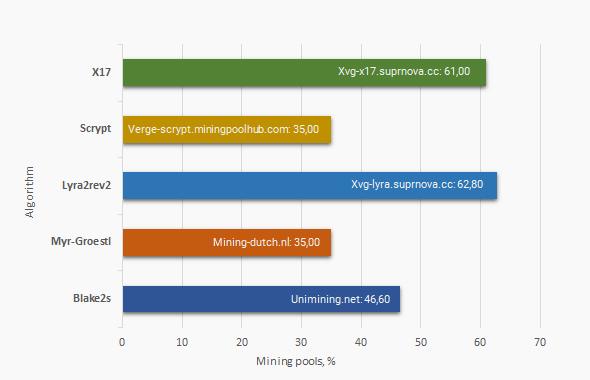Verge Mining Pools
1.00000000 XVG
| Total Hashrate: | N/A |
|---|---|
| Difficulty Level: | N/A |
| Block Time: | 2 min 30 sec |
Best Verge mining pools
Below you’ll find a list with top Verge mining pools in comparison for each of the algorithms available for XVG mining:
| Pool Website | Market Share/per algorithm* | Server Locations | Reward System | Pool Fee | Get all Details |
|---|---|---|---|---|---|
| unimining.net |
46.6 %
|
EU
|
|
0.5%-0.9% |
Read Review
|
| mining-dutch.nl |
35 %
|
EU
Asia
USA
|
|
2% |
Read Review
|
| xvg-lyra.suprnova.cc |
62.8 %
|
EU
Asia
USA
|
|
2% |
Read Review
|
| verge-scrypt.miningpoolhub.com |
35 %
|
EU
Asia
USA
|
|
1% |
Read Review
|
| xvg-x17.suprnova.cc |
61 %
|
EU
Asia
USA
|
|
2% |
Read Review
|
*Keep in mind, that estimations and values in the crypto world are not certain and constant.
As you can see from the table above, I have listed a few components of a Verge pool – market share, server location, fee, reward system, algorithm. Why there are different pools for each algorithm you may ask. The answer is simple – some hash functions are better suited for mining with ASICs and others for GPUs. Considering Verge is a multi-algorithm coin, the most suitable pools for each type of hash protocol operate on separate networks and thus have different difficulty and total hashing power.
If you want to learn the nitty-gritty of mining pools and how to choose the right one, check out the article for detailed instructions.
My work doesn’t stop here. I want to draw your attention to one small trick, which will ensure you’re mining all the time. It relates to the number of used Verge pools. I advise you to have several registrations, especially when mining involves multiple algorithms. No matter how safe a pool is, it’s internet and hardware dependent. Anything can happen. That is wh, make sure you have at least а few XVG pools at your disposal. When one is down, your wallet will automatically switch to the next one in line and continue mining Verge, or any other coin.
When I talk about mining and pools, another topic I should cover is rewarding systems. That is the method used for distributing the profit from each block found. This aspect has several key points, which I’ve explained in detail with the “Mining pools reward systems” article.
Mining pools without registration
The same way coins have two sides, so do registration requirements of mining pools. You can opt for detailed statistics after creating an account or you could simply join in and start mining with no pre-requisites. Here is a table with some of the best Verge mining pools without registration:
| Name | Fee | Pool Url | Worker | Password |
|---|---|---|---|---|
|
Hashfaster.com
|
1% | X17: stratum+tcp://hashfaster.com:3737Lyra2rev2: stratum+tcp://hashfaster.com:3740 | – | Any |
|
Zergpool.com
|
0%-0.5% | X17: stratum+tcp://x17.mine.zergpool.com:3737Blake2s: stratum+tcp://blake2s.mine.zergpool.com:5766Myr-GR: stratum+tcp://myr-gr.mine.zergpool.com:5433Scrypt: stratum+tcp://scrypt.mine.zergpool.com:3433 | – | Any |
|
Zpool.ca
|
1.5%-1.75% | X17: stratum+tcp://x17.mine.zpool.ca:3737Lyra2rev2: stratum+tcp://lyra2v2.mine.zpool.ca:4533Blake2s: stratum+tcp://blake2s.mine.zpool.ca:5766 | – | Any |
The usage of such pools is a no brainer. Considering I’m talking about mining, we should look into configuring your mining device. All you need to do is log on to your device’s management page/software and type in the URL and your wallet address.
Calculating my XVG Pool Mining Profits
Every parameter that has been added automatically can be adjusted to fit your needs.
Setting up your own Verge Mining Pool
The spine of every mining pool project is the Virtual Private Server or VPS. Here are the minimum requirements to run one:
- Dual Core CPU (Quad core if you want to support all Verge’s algorithms)
- 4GB of RAM memory (8GB or more if you want to support all Verge’s algorithms)
- 300GB of storage space to keep the blockchain of the coin ( more if you want to support all Verge’s algorithms )
- Uncapped bandwidth usage (incoming and outgoing traffic depends on how much users are connected and full-node block synchronization)
- Dedicated public IP address
In case you don’t have the opportunity to have your own server, you can always rent VPS from a provider. The only thing for you to do in this case is to install and configure the mining pool software. The only thing left is to start mining. If you decide to go rent your server, you avoid dealing with hardware devices, bandwidth and electricity.
Verge pool distribution

| Pool | Hashrate Share |
|---|---|
|
Unimining.net
|
46.6% |
|
Mining-dutch.nl
|
35% |
|
Xvg-lyra.suprnova.cc
|
62.8% |
|
Verge-scrypt.miningpoolhub.com
|
35% |
|
Xvg-x17.suprnova.cc
|
61% |
History and Future of Verge mining pools
Verge is a tasty bite for a lot of scammers because it is valuable. XVG’s security has been upgraded many times after it experienced a few 51% attacks. The team behind the currency has advised miners to use different algorithms for finding each block. This prevented a single pool to control the majority of the hashing power.
What the team did was patch the code with an emergency commit to the repo. In a later stage, this change evolved into a hard fork. Even after the attacks were handled, many people are still sceptic about using Verge mining pools.